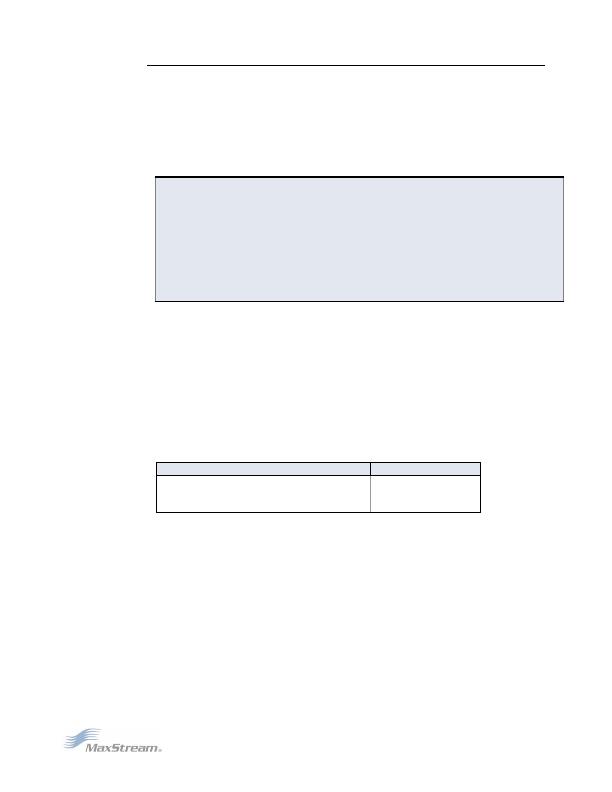- 您現(xiàn)在的位置:買賣IC網(wǎng) > Datasheet目錄58 > XIB-E (Digi International/Maxstream)BOARD INTERFACE ETHERNET Datasheet資料下載
參數(shù)資料
| 型號: | XIB-E |
| 廠商: | Digi International/Maxstream |
| 文件頁數(shù): | 39/64頁 |
| 文件大?。?/td> | 1858K |
| 描述: | BOARD INTERFACE ETHERNET |
| 標準包裝: | 1 |
| 附件類型: | 接口板 |
| 適用于相關(guān)產(chǎn)品: | XStream 和 Xcite 收音機 |
第1頁第2頁第3頁第4頁第5頁第6頁第7頁第8頁第9頁第10頁第11頁第12頁第13頁第14頁第15頁第16頁第17頁第18頁第19頁第20頁第21頁第22頁第23頁第24頁第25頁第26頁第27頁第28頁第29頁第30頁第31頁第32頁第33頁第34頁第35頁第36頁第37頁第38頁當前第39頁第40頁第41頁第42頁第43頁第44頁第45頁第46頁第47頁第48頁第49頁第50頁第51頁第52頁第53頁第54頁第55頁第56頁第57頁第58頁第59頁第60頁第61頁第62頁第63頁第64頁

XStream"燨EM燫F燤odule?燩roduct燤anual爒5.x00燵2006.02.24]?/DIV>
牋牘?006燤axStream,營nc.燙onfidential燼nd燩roprietary?/DIV>
39?/DIV>
Repeater Network Configuration
A network may consist of End Nodes (EN), End/Repeater Nodes (ERN) and a Base Node (BN).
The base node initiates all communications.
The repeater network can be configured to operate using Basic Broadcast or Basic Addressed
communications. The addressing capabilities of the modules allow integrators to send a packet as
a global packet (DT = 0xFFFF) and shift out of every radio in the network (Basic Broadcast).
Alternatively, the packet can be sent with a specific DT (Destination Address) parameter so that it
is only accepted by a specific remote node (Basic Addressed).
Configuration Instruction (Basic Broadcast Communications)
Assign each module a unique MY (source) address. (The AM (Auto-set MY) command will
configure a unique source address that is based on module serial number.)
Enable Basic Broadcast Communications (DT = 0xFFFF) or Addressed Broadcast Communications
(ATDT specifies a specific destination)
Configure PK, RO and RB to ensure that RF packet aligns with protocol packet. (ex. PK=0x100,
RB=0x100, RO depends on baud rate).
Configure one or more repeaters in the system (ATMD = 3).
Configure remote nodes as destinations (MD = 4). This will ensure that the remote node waits for
the repeater traffic to subside before it transmits a response.
The configuration instructions above reflect configuration for a Basic Broadcast Repeater system.
To configure a Basic Addressed Repeater system, use the DT (Destination Address) parameter to
assign unique addresses to each module in the network.
Algorithm details
" Packet ID (PID) is composed of transmitting module MY address and packet serial number.
" Incoming packets with a PID already found in the PID buffer will be ignored.
" Each module maintains a PID buffer 8 deep of previously received packets (managed as
FIFO).
Packets may be shifted out the serial port and/or repeated depending on the DT parameter
contained in the RF packet.
Table?02. DT?Destination燗ddress)爌arameter爐ruth爐able牋
Address Match
Send out serial port?
Repeat?
Global
Yes
Yes
Local
Yes
No
None
No
Yes
Repeat delay based on RSSI
A transmitted packet may be received by more that one repeater at the same time. In order to
reduce the probability that the repeaters will transmit at the same instant, resulting in a collision
and possible data loss; an algorithm has been developed that will allow a variable back-off prior
to retransmission of the packet by a repeater. The algorithm allows radios that receive the packet
with a stronger RF signal (RSSI) to have the first opportunity to retransmit the packet.
The RN (Delay Slots) parameter is used to configure this delay. Set RN=0 (no delays) for small
networks with few repeaters or repeaters that are not within range of each other. Set RN=1 for
systems with 2 to 5 repeaters that may be within range of each other.
The actual length of the delay is computed by the formula:
Delay (ms) = L * DS
DS = (-41-RSSI)/10*RN)+RandomInt(0,RN)
Where L is the length of the transmitted packet in milliseconds, DS is the number of delay slots
to wait, RSSI is the received signal strength in dBm, RN is the value of the RN register and
RandomInt(A,B) is a function that returns a random integer from A to B-0
相關(guān)PDF資料 |
PDF描述 |
|---|---|
| XIB-R | BOARD INTERFACE RS232/485 |
| ZMN2400HPDB | BOARD ROUTER DEV ZIGBEE 100MW |
| ZMN24HPDK-B | KIT DEV W/ZIGBEE ZMN2400HP |
| ZNI1000TC | IC TEMP SENSOR NI1000 SOT23-3 |
| 02110102-000 | SNSR TILT RATIO 60DEG 500MA FLNG |
相關(guān)代理商/技術(shù)參數(shù) |
參數(shù)描述 |
|---|---|
| XIB-R | 功能描述:界面模塊 RS-232/485 interface 24XStream 9XCite RoHS:否 制造商:4D Systems 產(chǎn)品:Serial Converters 通道/端口數(shù)量: 數(shù)據(jù)速率: 接口類型:USB, UART 工作電源電壓:3.3 V, 5 V 最大工作溫度: |
| XIB-U | 功能描述:界面模塊 USB interface board 24XStream 9XCite RoHS:否 制造商:4D Systems 產(chǎn)品:Serial Converters 通道/端口數(shù)量: 數(shù)據(jù)速率: 接口類型:USB, UART 工作電源電壓:3.3 V, 5 V 最大工作溫度: |
| XIC25040 | 制造商:XIC 功能描述:25040 24HR '6 |
| XILINXPWR-079 | 功能描述:電源管理IC開發(fā)工具 Pow Mgt Eval Mod for Xilinx FPGAs RoHS:否 制造商:Maxim Integrated 產(chǎn)品:Evaluation Kits 類型:Battery Management 工具用于評估:MAX17710GB 輸入電壓: 輸出電壓:1.8 V |
| XILINXPWR-080 | 功能描述:電源管理IC開發(fā)工具 Pow Mgt Eval Mod for Xilinx FPGAs RoHS:否 制造商:Maxim Integrated 產(chǎn)品:Evaluation Kits 類型:Battery Management 工具用于評估:MAX17710GB 輸入電壓: 輸出電壓:1.8 V |
發(fā)布緊急采購,3分鐘左右您將得到回復(fù)。